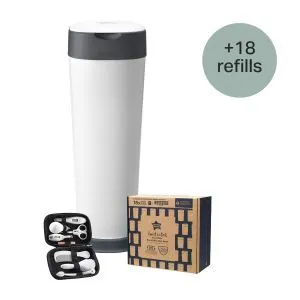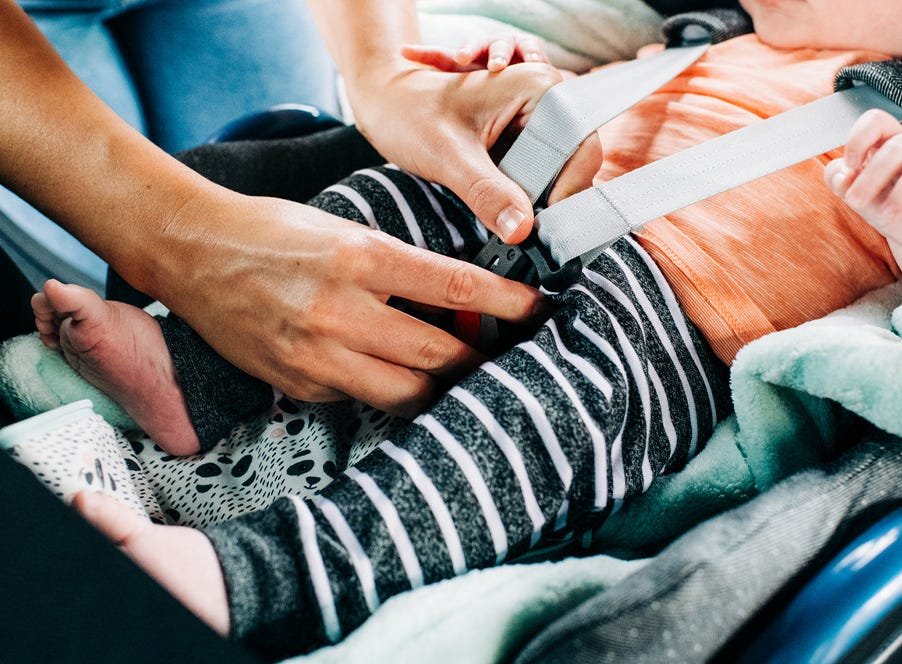
Ultimate XL Nappy Disposal Bundle with 18 Refills
Bundle & Save 40%
Subscription orders can be cancelled at anytime. Free delivery on all subsequent subscription orders. Find out more about subscriptions.
They’re easy and fuss free
Your products are automatically sent to you
You save up to 10% when you sign up for a subscription
You can cancel at any time
When to Travel with Newborn by Car & How to Keep Your Baby Safe

At first, driving with a newborn is a daunting prospect for any parent. From the first drive home after leaving the hospital, to hopping in the car to visit excited friends and relatives for the first time, it can be a cause for concern.
Will your baby sleep? Are they comfortable and safe? Don't worry! We've come up with a list of top tips and must-have essentials especially for expectant parents to make sure your baby's first trips out in the car are a breeze.
First things first, you're going to need a car seat. Here are a few pointers to help you choose a car seat that's safe and perfect for you and your baby:
If you can, you should make sure you've got your baby's car seat ready to go before they're born.
When choosing a car seat for your newborn baby, you need to make sure you get one that's suitable for use from birth, fits in your car, and that it's installed properly. Lots of retailers offer a fitting service alongside purchase and should explain how to fit the car seat step-by-step so you know how to do it confidently.
Buying pre-loved baby products can be a great way to save money and help the environment, but it's recommended that parents don't buy or use a second-hand car seat. This is because you can't be 100% certain of its history, and don't know if it has been involved in an accident or has damage that's not visible.
If your baby is going to travel in other cars as well as your own - with their grandparents, for example - you should make sure that the car seat you choose will fit in their car too.
It can also be helpful to see if your car has ISOFIX connectors built in because these make fitting car seats easier. Most modern cars will have them in the back seats between the padding.
All baby car seats must conform to strict safety standards, including at least one of the following:
To make sure your baby's car seat is up to standard, check for the 'E' mark label on the seat.
It's so important that your baby's car seat is installed correctly before every journey. Follow all the safety instructions and make sure it's right for their height and weight.
Once installed, you need to make sure your baby is strapped in following the manufacturer's instructions. You should always put your baby into their car seat in the back passenger seat from the pavement side of the car to keep you both safe from on-coming traffic.
Once they're strapped in, you should never leave your baby alone in the car, not even for a minute.
If your baby is going to be alone in the back seat while you drive, you could invest in a set of rear-view mirrors so you can keep an eye on them. And don't forget the classic 'Baby on Board' sign. These signs are designed to alert the emergency services that your baby is in the car, so be sure to take it out when you're travelling solo!
Don't pack luggage on the back seats of your car and keep the seat next to your baby clear if you can. That way, someone can sit next to them and soothe or entertain them as you drive.
If you're travelling during the day, you can use window shades to protect your baby from the sun and create a dark, calm environment. Keep an eye on the temperature in the car and don't let your little one get too hot or cold.
Make sure that you have a few baby-friendly playlists ready to go. Think soothing sounds and nothing too loud. Classical music or lullabies should work to keep those little ears happy.
You're never going to get anywhere as fast as you did before you became a parent, so it's important that you ease into a slower state of mind.
During long car journeys, it's recommended that parents schedule regular stops every 30 minutes to get some fresh air and give their baby time to stretch their limbs out. You can also use these breaks to breastfeed or bottle feed your little one if they're due a feed.
There are lots of products out there designed to make car journeys more comfortable for newborns, babies, and toddlers. The essentials we think you'll need include...
Explore the Range
There's no published research that gives an exact amount of time that a baby can stay in a car seat. However, experts advise that children under four weeks shouldn't be in their car seat for longer than 30 minutes at a time, and that all babies shouldn't be in their car seat for more than two hours.
Research by the University of Bristol on car seats and SIDS (sudden infant death syndrome) concluded that there may be a higher risk of breathing difficulties in young babies if they're in an upright position while travelling for too long. So, make sure you take plenty of breaks during longer car journeys. In addition, babies are at a greater risk of SIDS if they overheat. Therefore, ensure that you remove any outdoor clothing, such as hats and coats, when your little one is in the car, even in winter.